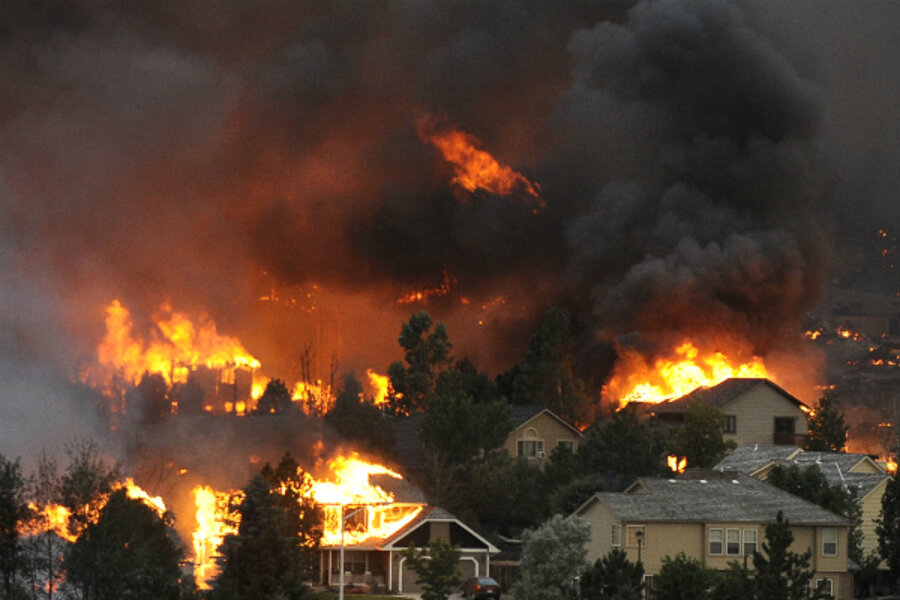Unexpected legacy of wildfires and other emergency events: innovation
| Los Angeles
The fires raging in the western US have now claimed at least one life in Utah, and tropical storm Debby has flooded homes and closed highways in Florida.
While this damage is devastating and costly to many, these crises – and others like them – leave a small silver lining in their wake: They help propel technological innovation. Their ability to capture public concern – and funding – helps spur development of new technologies as well as new uses for existing ones.
Media attention during crises jump-starts public awareness of critical, life-saving needs, both immediate and longer term, says Donald McKeown, from the Rochester Institute of Technology (RIT) Information Products Laboratory for Emergency Response (IPLER) in New York.
“Funding for the development of many vital technologies can be very difficult when there is no emergency in the news,” he says, so awareness and momentum built during emergencies can be essential to being better prepared for future crises.
The RIT Lab has a four-year grant from the National Science Foundation and is partnered with the US Forest Service and the Department of Homeland Security, as well as private businesses, to develop airborne geo-spatial imaging for use during fires and floods.
In 2011, after tropical storm Irene devastated areas along the Schoharie Creek and the Mohawk River in upstate New York, an RIT engineer and sensor operator joined a team in a twin-engine Piper Navajo that flew over the entire flood zone, covering 28 square miles and capturing 1,400 images in a 3-1/2-hour flight. State emergency managers accessed images of the entire flood zone and used the imagery for recovery planning and damage assessment.
The four-camera system combines high-resolution color with infrared imaging and uses laser pulses to make precision elevation measurements. The lab’s airborne system delivers comprehensive overviews within 24 hours, compared with satellite systems that are less available, dependent on good weather, and take days to deliver final information.
Crises around the globe are pushing similar innovation:
- Last year’s quake in Japan led a Japanese inventor to create personal fiberglass pods, dubbed “Noahs,” that can hold four people and float for at least an hour in a fast-moving tsunami wave. A redesign of an earthquake-protection pod, a Noah now sells for some $4,000.
- After the 2004 Banda Aceh tsunami wiped away the Indonesian region’s entire landscape of homes and businesses, an Asian businessman created Aerial 3D, which uses laser beams to create text out of tiny, luminous dots projected in midair for emergency communications where no infrastructure can be accessed. It is now available for rental.
- After the shootings of students at Virginia Tech University, a small firm, Ping4, designed a mobile alert system that can wake up a dormant phone or override a mute function to deliver real-time, location-based, rich-text emergency information. Available since the first quarter of 2012, it is now being used in some 100 police departments and a growing number of the nation’s 4,200 colleges and universities
- On June 28, EarthRisk Technologies, along with the Scripps Institution of Oceanography, unveils new technology for projecting extreme weather events up to 40 days out – longer than today’s most advanced supercomputers, for which forecasting beyond 10 days is extremely difficult due to the number of variables involved. This new system involves crunching massive amounts of data over 82 billion calculations using 60 years of historical weather records to identify key patterns, which are compared with current conditions to determine what should happen next. The data can be used by everyone from large energy companies to prepare for bad weather to the National Hurricane Center to reduce the error rate of its forecasts.
“Innovation doesn’t come during a crisis; it flows from the aftermath of the crisis,” notes Tim Trainer, interim general manager of the Military Robots Business Unit at iRobot, a consumer robotics firm that began to retool in the wake of 9/11. The firm now has contracts with the Department of Defense. It deployed robots for the recovery mission immediately after the 9/11 terrorist attacks and redesigned them for use in Afghanistan and Iraq to combat and identify improvised explosive devices before they hurt soldiers.These were also sent to Fukushima, Japan, last year to provide images of the melting nuclear reactors and provided fire-hose support, so humans would not have to be exposed to radiation.
After the BP oil spill in the Gulf of Mexico, iRobot’s Unmanned Underwater Vehicle was used to locate and monitor large clouds of dispersed oil droplets at depths of approximately 2,296 feet and, in Antarctica, to gather never-before-recorded data on plankton, used to interpret “how life on this planet is created and destroyed.”
Innovation is critical not just to improve life-saving and mitigation in the immediate aftermath of an acute disaster, but to tackle the slow-moving crises such as climate change and energy usage, says Pace University law professor Elizabeth Burleson, an environment and energy specialist. Environmentally sound innovation is vital for a planet headed toward a 9 billion population before the end of the century, amid increasing climate change and depletion of natural resources. Funding for new technologies, even simple ones, such as energy-monitoring devices in people’s homes, continues to hinder their usage in poorer countries, she says.
But, she notes, partnerships between developed and less-developed countries will be vital. Such “networking may be able to shepherd whole renewable energy sectors across the innovation valley of death and help turn a global responsibility to ramp up green technology into a global initiative,” she adds, via e-mail.





